An Assessment of the Conditions Affecting Entry into the Scottish Fishing Industry and Potential Policy Responses
New entry into the Scottish fishing industry is commonly perceived as a self-evident necessity for the long-term prosperity of the sector and its absence a signal for government intervention. The remit of this paper is to explore whether prohibitive condi
3. The Age Structure of the Scottish Fishing Industry: Is there a problem?
3.1 The Age Structure of the Scottish Workforce
There is a perception that the workforce in the Scottish fishing industry is ageing. This coincides with a general trend of changing age structures in Europe, the UK, Scotland and global workforces. Figure 2 illustrates the age distribution of employees in the EU, UK, Scotland and the Scottish fishing industry in 2012. All labour forces follow the same general profile with the highest proportion of workers in the 35-49 year old age cohort followed by the 20-34 year old age cohort [1] . The UK and Scotland have higher rates than the EU as a whole in the 16-34 ages cohorts and lower rates than the EU for 50-64, suggesting younger workforces overall in the UK and Scotland.
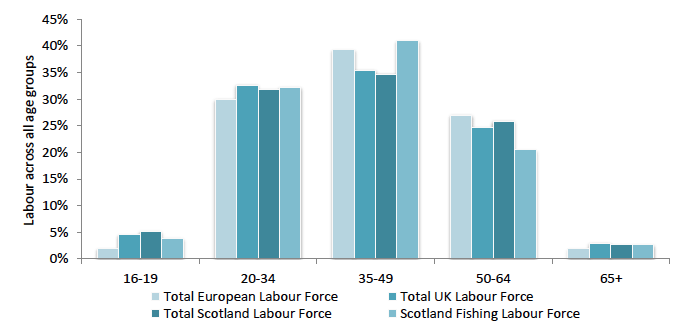
Figure 2: Proportion of UK, Scottish and Fishing employment cross age groups in 2012. Data on the Scottish and UK Labour force was sourced from NOMIS ( ONS 2014), EU Labour Force data sources from Eurostat.
In the case of the Scottish workforce: there is a slightly higher proportion of older workers in the 50-64 cohort compared with the UK, however this is again lower that the proportion of workers in Europe. Overall because of the cumulative impacts of improved health, rising life expectancy, falling birth costs and the rising costs of financing retirements all workforce are ageing which has led to a re-evaluation of the traditional labour market withdrawal age (Office for National Statistics, 2013), with the default retirement age of 65 phased out from 2011 in the UK. As a result, the proportion of older workers in the labour force is expected to rise (Office of National Statistics, 2013).
3.3 The Age Structure of the Scottish Fishing Industry in 2012 [2]
When compared to the age structure of EU, UK and Scottish employment, the Scottish fishing industry appears to have employed a proportionate number of younger workers: the average age of the fishermen surveyed was 39.4 years and the highest proportion of fishers are found in the 35-49 age cohort. There are fewer older (50-64) workers within the industry, which is also typical of the trends found in the total Scottish and UK workforce, as is the case for the 16-19 year olds but this is still higher than in the EU as a whole (Fig. 2). The industry therefore appears to have a relatively young workforce - with greater representation in the 25-34 age cohort, than the 50-64 cohort - most likely due to the industry's requirements for younger, fitter workers than the wider economy due to the physically demanding nature of the work.
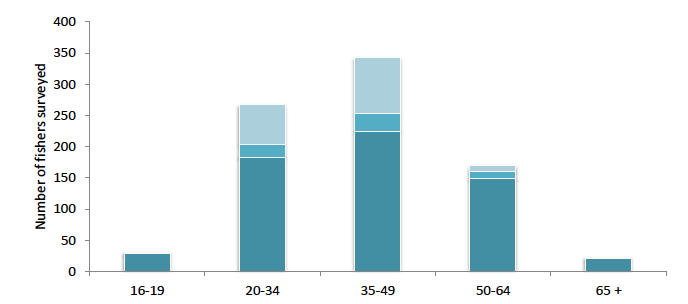
Figure 3. Age profile of Scotland fishermen by British, EU member and non- EU member nationalities. Source: MSS 2013 Survey of Fleet Employment (provisional)
Recent data on the composition of the nationality of fishing crews suggests that foreign workers are contributing to the younger age cohorts - 20-34 and 35-49, accounting for 31% and 35% respectively of crew in those age groups in 2012. For the 16-19 year olds, all are British workers and just under 70% of the 20-34 year olds are British suggesting new workers are coming from a diverse range of backgrounds but that the majority are still British. Nonetheless, a significant proportion of the 20-49 age range is made up of Non- EU member workers. As this has the potential to increase over time, government intervention may be warranted in line with the Government's economic strategy and its aspirations for the fishing industry. This intervention could take the form of better and more regular monitoring of labour market trends in the industry over the next few years.
3.2 The Age Structure of the Global Fishing Industry
From a review of the available evidence concerning the age structure of the global fishing industry, it is evident that these trends are not distinct to Scotland. Internationally, national fleets are increasing employing foreign crews. The trend within developed nations is for a continued reduction in the number of young people entering the industry and an increased number of fishers over the age of 60 and the difference in balance is being made up by foreign workers. The literature shows this to be the case in France, the US, Japan and Australia (Institute for Regional and Rural Research, 2004).
Analysing the age structure of the Scottish fleet by sector provides greater insight in Scotland. For instance, it appears that in the demersal and Nephrops sectors, a smaller percentage of the workforce is under 21 compared to in creel fishing and mechanical dredge sectors (Fig. 5). Moreover, in the creel fishing, Nephrops trawls and mechanical dredge sectors there is a higher dependence on workers over the age of 51 in comparison to the demersal fleet.
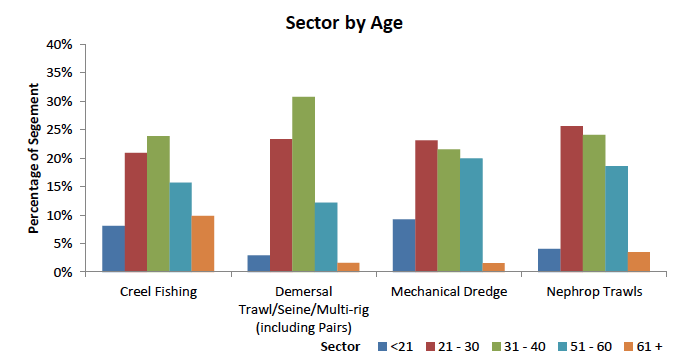
Figure 5. Sector by Age. Source: MSS 2013 Survey of Fleet Employment (provisional)
When breaking down the age cohorts by position, it could be surmised that it is easier for a young fishermen to gain a position upon a vessel as a deckhand (Fig. 6). The data also demonstrates a positive relationship between age and position held as skipper, therefore, it would appear less young fishers enter at this position. This cannot automatically be regarded as evidence of a barrier to entry (financial cost of acquiring vessel and quota) as it is rational that younger fishers enter the industry as deckhands and transition to the position of skipper over time as experience and income is accumulated.

Figure 6. Age by Position. Source: MSS 2013 Survey of Fleet Employment (provisional)
Breaking this down by sector, there appears to be fewer young skippers in the demersal and mechanical dredge sectors (Fig. 7). The mechanical dredge sector in particular shows an overreliance on older skippers, those over 41, than in the other sectors. As the position of skipper is overwhelmingly held by older fishers over the age of 51 an issue for new entry may be that if older fishers/skippers refuse to leave the industry (either due to a lifestyle choice or debt) this may affect the recycling of quota, licence and vessel ownership opportunities to younger fishers.

Figure 7. Age of Skippers in each Sector. Source: MSS 2013 Survey of Fleet Employment (provisional)
3.4 Retention of young workers: The retention levels amongst younger fishers may also be an issue affecting the age structure of the Scottish industry. In the industry engagements, this was flagged by all representatives as a barrier. One informant commented that good fishermen tend to leave the industry as their skills are transferable to the Merchant Navy, the offshore sector in the North Sea and the renewables sector in Holland, with the catching sector unable to match the good terms and conditions offered by these industries. A point made was that retention was not only undermined by competition from other marine sectors, but that uncertainty within the industry itself was a problem affecting the enthusiasm of young workers. A consensus was that amongst young people around the coast, enthusiasm towards the industry exists. It was felt by industry representatives that if the problems facing the industry (specifically in relation to the problems of gear conflict and competition for ground for the inshore sector) could be improved, the industry could present itself as a more attractive package and this enthusiasm could be harnessed.
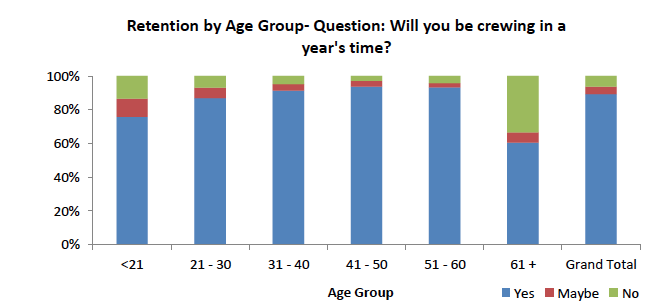
Figure 8. Retention by Age Group: "Will you by crewing in a year's time?" Source: MSS 2013 Survey of Fleet Employment (provisional)
Evidence within the 2013 Survey of Fleet Employment supports the notion that retention is an issue amongst younger workers. Of the under 21s, 14 per cent were sure that they would not be crewing in a year's time, with 11 per cent unsure if they would remain in the industry (Fig. 8). Aside from the over 61 age group who had the lowest level of retention, most likely on account of the prospect of retirement, retention appears to affect the youngest age group the most.
Data collected from a series of key informant interviews with POs and industry fishing associations indicates that the factors influencing lower retention rates amongst younger fishers are the work and pay conditions the industry offers. Working conditions in the catching sector were stated as less attractive because the work is physically demanding and dangerous and there is a high degree of uncertainty over working patterns e.g. when and for how long the vessel will be at sea. In an interview with a PO based in the North-East of Scotland regarding the issue of new entry, it was commented that trainees tend to last only a few trips: as the work is hard, they either move to go on a smaller boat or else into the oil industry. All sectors spoke of weather conditions having the potential to undermine the security of receiving a weekly wage. This is not necessarily all negative as it is worth noting that young people in rural areas use the industry to gain experience to access other marine careers, with a host of benefits of rural areas as a whole (Jones, 2013). Equality in most industries it is expected that young people will likely try a job for a period of time before deciding it is not for them, therefore it is hard to confirm whether this is a particular problem for the fishing industry or the general behaviour of young people finding suitable and enjoyable employment.
3.5 Competitiveness of the Scottish Fishing Industry Compared to other sectors such as oil and gas and marine renewables who can offer greater security over working patterns, the average wages across the fishing sector are less in comparison. Therefore, the often unattractive nature of the work is not necessarily offset by a comparable financial pay-off, which the aforementioned sectors can guarantee.
Table 1: Estimate of wages for selected Scottish fleet segments, average 2009-2011 Source: Marine Scotland estimates based on Seafish data. UK wage data from ONS and gov.uk
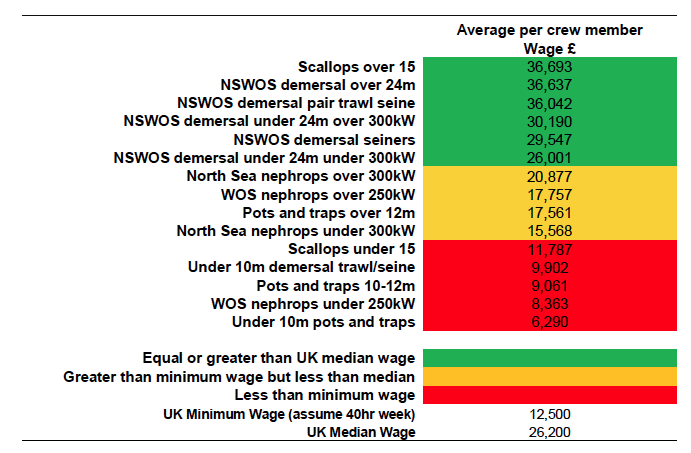
In terms of wages across the fleet, some sectors fair better than others when compared with the UK average (not accounting for hours worked which are generally higher than the UK average). The North Sea and West of Scotland demersal over 24 meter, pair trawl and seine fleet are estimated to award average wages above the UK median wage, with the over 15 metre scallop dredge offering very attractive wages (Table 1). Wages on Nephrops vessels are relatively low on average and do not compare well to the UK median wage. Wages in the static gear segments are also low, sometime below minimum wage although this may be due to part time nature of the work rather than low wages per se. One possibility is that if the profitability of the vessels targeting Nephrops could be improved (Table 2), better wages could be offered thereby attracting new entrants into the sector. The issue of profitability and wages as a barrier to some sectors was identified within the talks with industry representatives. For instance, it was commented that the pelagic sector does not experience issues with recruiting new, young labour as it is able to offer high wages. It was also commented that the recruitment of young crew is more difficult in the mobile sector as opposed to the static sector due to high operating costs and the current crew share system. Moreover, two POs stated when there was relatively more young people entering the industry over 20-30 years ago, this was driven by their ability to earn a much higher wage. Through the industry engagements, there was a strong consensus that if the labour supply of the catching sector is to be improved, a key mechanism for achieving this is to improve the economic performance of the industry. It is through increased profitability that better wages can be paid, which will incentivise younger workers to enter and remain in the industry.
Table 2: Estimate of profits for selected Scottish fleet segments, average 2009-2011 Source: Seafish
| Average per vessel |
|
|---|---|
| Profit £ |
|
| Scallops over 15 |
128,719 |
| NSWOS demersal seiners |
57,505 |
| NSWOS demersal under 24m under 300kW |
48,867 |
| NSWOS demersal pair trawl seine |
37,344 |
| NSWOS demersal over 24m |
35,682 |
| NSWOS demersal under 24m over 300kW |
31,187 |
| Pots and traps 10-12m |
15,910 |
| WOS nephrops under 250kW |
12,889 |
| Pots and traps over 12m |
11,848 |
| Under 10m demersal trawl/seine |
11,531 |
| North Sea nephrops under 300kW |
10,346 |
| WOS nephrops over 250kW |
9,498 |
| Under 10m pots and traps |
8,472 |
| North Sea nephrops over 300kW |
4,434 |
| Scallops under 15 |
1,918 |
Contact
There is a problem
Thanks for your feedback